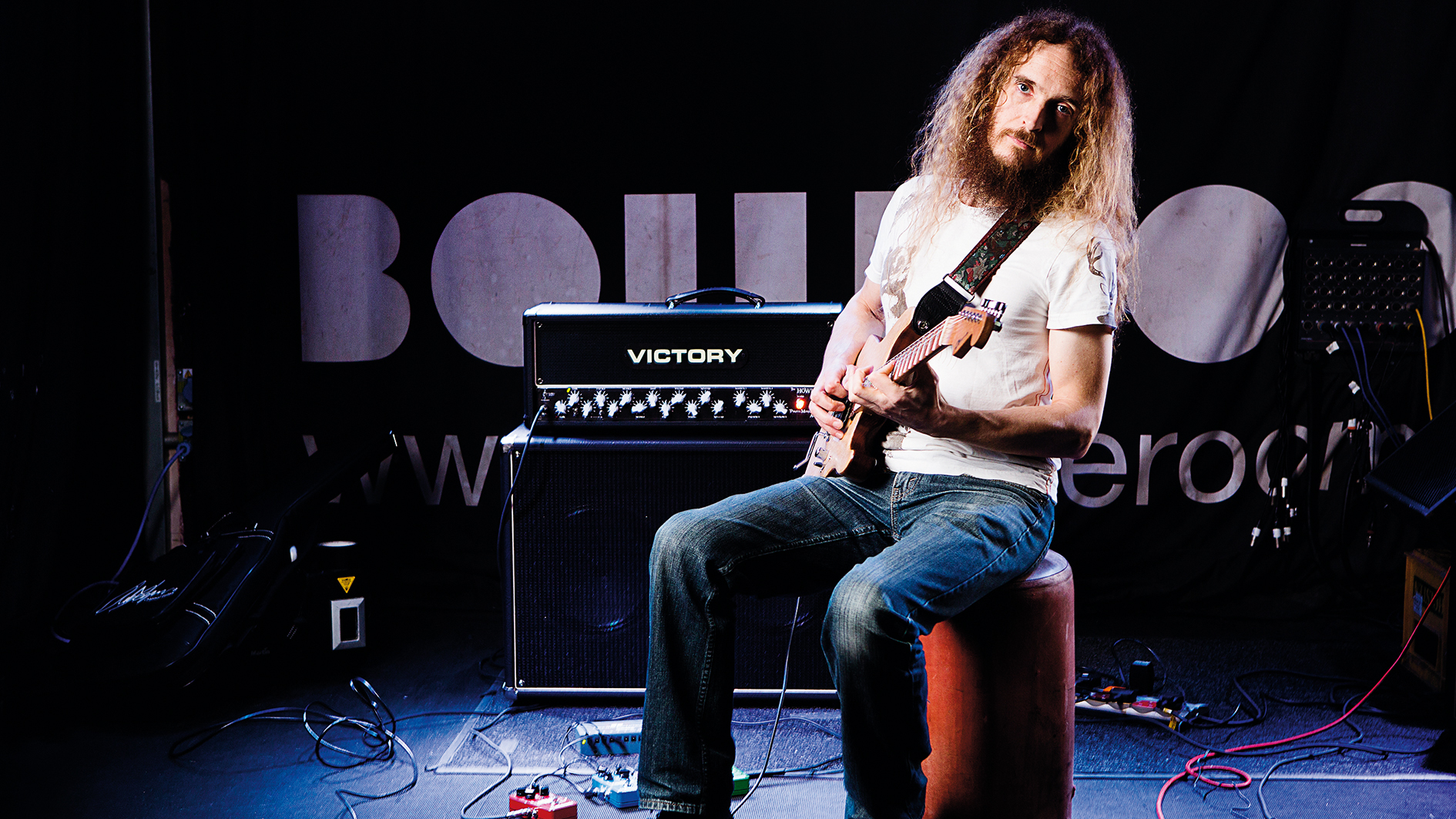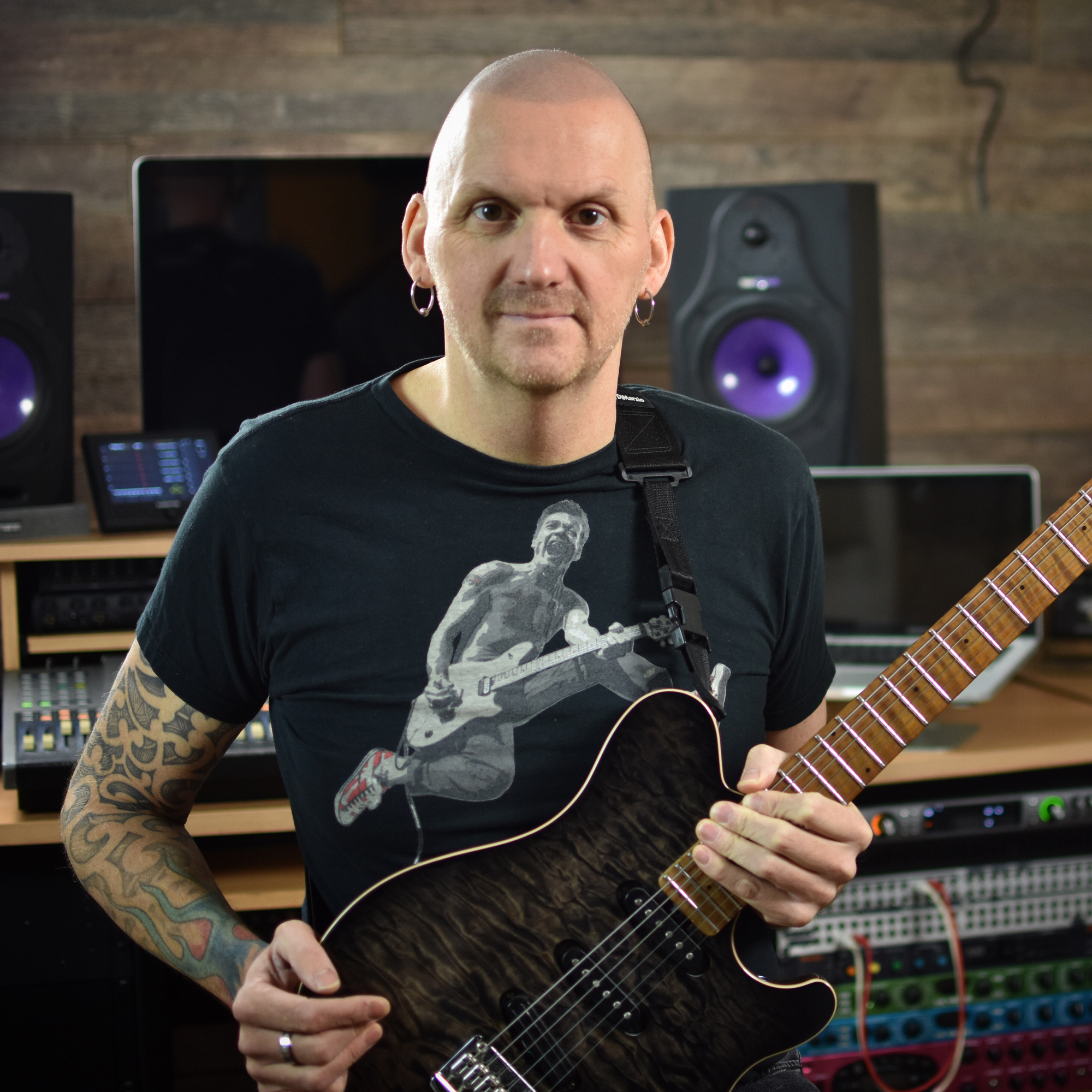Learn 60 years of legato guitar in 5 generation-spanning lessons
Master the evolution of legato technique from the '70s to the present day, spanning Eddie Van Halen to Steve Vai and Guthrie Govan

Legato is a ‘must have’ technique when developing your skills as a guitarist. It’s a way to play smooth, fluid lines, as opposed to the more regimented and percussive sound of alternate picking.
Legato is performed with hammer-ons, pull-offs and slides played with the fretting hand. It can produce long, flowing runs, often associated with instruments such as saxophone. It’s not uncommon to hear jazz and fusion guitarists using legato to mimic their wind instrument brethren, while rock guitarists use it to execute smooth runs over extended positions at high speed.
The technique has evolved greatly over the past 60 years, with guitarists forever exploring and pushing boundaries. The 1970s saw huge changes in guitar post Hendrix and Clapton. Jimmy Page, Paul Kossoff and others had been employing legato in fairly basic form, using blues-based Pentatonic ideas, but in 1978, rock guitar was reinvented overnight, with the release of Van Halen 1.
Eddie Van Halen applied legato to rock guitar in a way that had not been seen before. Eddie discovered that by using tapping he could play three-notes-per-string licks and ‘movable shapes’ to create all manner of tonalities.
He could produce wide Pentatonic licks and arpeggios, or play Clapton-inspired lead lines, adding extra notes with his tapping finger. This album laid the foundations for even more technically impressive playing.
Through the late-'70s and into the '80s, Eddie’s impact was the catalyst for huge developments in rock. It was the dawn of ‘shred’. Steve Vai and Joe Satriani sounded ‘schooled’ and refined.
They employed legato as away of traversing the neck through all the positions of the scale system, enabling them to play incredibly fast over standard and modal progressions. Paul Gilbert’s string-skipping with legato produced unorthodox sounding licks, and was a more manageable way of sequencing arpeggios.
But perhaps the Daddy of legato is Allan Holdsworth. Holdsworth played almost exclusively this way, executing wide stretches, arpeggios, and endless fluid lines at impossible speed. His approach to playing ‘outside’ had a huge impact on Van Halen; check out Eddie’s solo on Drop Dead Legs. Other notable legato players from this era include Richie Kotzen, Reb Beach and Nuno Bettencourt.
During the 1990s, guitarists pushed legato technique to even higher levels. Rusty Cooley and Ron 'Bumblefoot' Thal applied wide stretches and string skipping to Pentatonic licks, producing terrifyingly fast lines, while Thal and Brett Garsed developed four-notes-per-string techniques for even greater speed.
Guthrie Govan's lines are extremely precise, often embellished with chromatic passing notes, or wide stretched string skips with tapping
Garsed used a hybrid picking approach that enablid him to emphasise rhythmic subdivisions; legato players typically played across the beat, whereas Brett’s rhythmic emphasis aligned more with alternate picking. Dream Theater’s John Petrucci popularised legato sequences embellished with tapping and sliding.
Into the 2000s and we have players like Guthrie Govan. Guthrie is a master of all techniques, and can play a multitude of styles to an extraordinary level. His lines are extremely precise, often embellished with chromatic passing notes, or wide stretched string skips with tapping. Other noughties stand-outs include SlipKnot’s Jim Root and Mattias Al Eklundh.
Today, YouTube has become a huge resource for guitarists, and a great vehicle for showcasing players. Tom Quayle is one of the most popular guitarists within the online guitar community.
He has developed new approaches and uses legato to perform sequences within his runs. He tunes his guitar in 4ths, which enables him to ascend and descend scales without having to change position.
It’s a great example of how Tom has refined his style around the legato approach, and he is one of many players who are constantly pushing the boundaries of this and many other guitar techniques. Some other great modern players you might like to check out in this field include Nick Johnston, Danielle Gottardo and the incredible Max Ostro.
Technique focus: Legato technique
To maintain a fluid technique it’s important to stay relaxed. There are two main moves you will need for legato: a hammer-on, where you sound a note by hammering the finger onto the string, and the pull-off, where you pull the finger away from the string.
This is a little harder to achieve, although we also see the even trickier ‘hammer-on from nowhere’, where you sound the first note of a run when changing strings without picking. Keep your fingers no more than a few millimetres from the strings for a more economical technique.

Basic finger exercises will help with stamina, but also work on different combinations of fretting-hand fingers, as this will help to develop independence. It’s also important to practise things like three-notes-per-string whole-tone stretches, as well as even wider ones, like stacked tone-and-a-half exercises. The three-notes-per-string scale system lends itself well to legato playing, enabling you to cross the strings with consistent three-finger patterns.
Work on an even and constant dynamic level, too, as you don’t want drops in volume depending on what finger is making contact with the string, or differences in dynamic level between hammer-ons and pull-offs.
I would also suggest levelling the dynamics between the first picked note and any upcoming hammer-ons or pull-offs – try picking slightly softer so the first picked note doesn’t jump out. Sometimes when descending a run of pull-offs, don’t pick at all, but sound the first note on each string with a hammer-on. This results in a very smooth and slippery legato style.
Get the tone
Amp settings: Gain 8, Bass 6, Middle 7, Treble 5, Reverb 3
Almost all the guitarists referenced in this article use high-gain rock tones, although each will have his own nuances, be it guitar or amp type used, which effects and so on.
Go for a good generic rock sound, whether using single-coils or humbuckers. Neck pickup will sound smoother, and try a fairly soft-toned drive pedal. Overdrive or distortion is a great aid to legato so use the above settings as a starting point and add reverb/delay to taste.
Example 1. 1970s Legato
Our first track has its feet firmly planted in 70s hard rock and metal. The clear inspiration for this track was game-changing early Van Halen.
[Bars 1-4] We kick off with some typical EVH-inspired licks. The first utilises the whammy bar, scooping into the notes as we initially hammer on. Bars 3-4 include a typical Eddie-style Pentatonic phrase showing his Clapton influence. Look out for the ‘hammer-on from nowhere’ at the 14th fret, third string.
[Bars 5-8] These licks are inspired by Dave Murray. This section includes fast trills, as well as a descending figure that includes hammer-ons, pull-offs and slides.
[Bars 9-12] More Van Halen inspired licks, similar to those heard in that most famous piece! The first lick uses odd note groupings, and includes the open second string. We conclude with a typical three-notes-per-string figure.
[Bars 13-16] These licks are in the style of Patto’s Ollie Halsall, who was an influence on both Alvin Lee and Allan Holdsworth. This lick includes some arpeggios that climb chromatically adding an outside tonality to the solo. We conclude this section with some wide-stretch string-skipping phrases.
[Bars 17-20] Even more Van Halen goodness, kicking off with an example of Eddie’s wide stretch shapes that he often employed in his solos. We conclude with his signature ‘Falling down the stairs and landing on your feet’ approach with a shape that’s consistent across the neck.
[Bars 21-23] We conclude our first solo with more Van Halen licks, kicking off with a much used idea that builds intensity as it climbs the top two strings using typical three-notes-per-string fingerings.
Example 2. 1980s Legato
This example is a solo inspired by the shred guitarists of the 80s. The inspiration for this backing track was Extreme, Mr Big and Zakk Wylde.
[Bars 1-5] We kick off with a Joe Satriani inspired legato phrase, similar to ideas heard on Flying In A Blue Dream. Notice how the lick includes held notes followed by fast flurries and position shifts. This lick is very demanding as you only pick once at the very beginning of the phrase.
[Bars 6-9] These bars include a position shifting lick inspired by both Joe Satriani and Steve Vai. Pay attention to the position shifts performed with slides. This lick is based around the F# Aeolian mode, the sixth mode of the A Major scale.
[Bars 10-13] And Paul Gilbert has joined the solo! We continue with some signature position shifting legato patterns on the top two strings. Notice how this lick is rhythmically organised, and great for the timing and synchronisation.
[Bars 14-17] This Paul Gilbert-style Pentatonic string skipping lick is very demanding, so take care when jumping strings. When performed accurately it will produce a wide intervallic sound. We conclude this section with a Richie Kotzen inspired wide stretch Blues scale lick. This lick is embellished with tapped notes for added Richie style intensity.
[Bars 18-22] Now here’s a string skipping and tapping arpeggio figure in the style of Nuno Bettencourt, which follows the accompanying chords. Again take care when crossing the strings, and make sure you sound the strings with fretting-hand hammer-ons. We conclude these bars with a classic stretching Pentatonic/Blues scale lick in the style of the great Zakk Wylde.
[Bars 22-25] A great example of how Paul Gilbert uses legato to perform smooth and clean arpeggios with the fretting hand. We end with an ‘outside’ shape-based lick inspired by Allan Holdsworth and Shawn Lane. Take care with this figure as it includes stacked Minor 3rds, so good fretting-hand positioning is vital.
Example 3. 1990s Legato
For this '90s-inspired track inspiration was sourced from Dream Theater and 90s Shrapnel Records instrumental rock and fusion players. This track differs from the others as it features key changes, modulating between E Dorian and E Lydian.
[Bars 1-3] We introduce our solo with a lick inspired by Rusty Cooley, Derek Taylor, Ron Thal and Darren Householder. It features wide stretch E Minor Pentatonic fingerings that also include string skipping. We also shift position maintaining three-notes-per-string patterns. The lick also include tapping embellishment. Take care with this one as it’s very demanding.
[Bars 4-8] Here’s our first modulation, shifting to E Lydian, so remember, your scale shapes have changed from the first section. This section is pure John Petrucci, with a four-notes-per-string fretting-hand pattern with an additional tapped note. Yes, five-notes-per-string! This lick produces fast, smooth flurries.
[Bars 9-12] Some Ron Thal inspired licks now, starting with a multi-finger string-skipped tapped arpeggio figure. We are back to E Dorian, and for this lick I suggest tapping with the second and third fingers of your picking hand. Again take care when skipping strings. We conclude with a fast five-note depending chromatic scale lick, that implements tapping.
[Bars 13 -16] And back to E Lydian. This lick is inspired by Brett Garsed, although it doesn’t include hybrid picking, but feel free to experiment! The idea of this lick is to include chromatic embellishment as well as four-notes-per-string fingerings to create a smooth, fluid sound.
[Bars 17-21] We conclude our solo with a melodic legato and tapping figure inspired by Meshuaggah’s Fredrik Thordendal. Yet more key changes, starting in A Lydian, before modulating to C Lydian, D Mixolydian, and resolving to E Major.
Example 4. 2000s Legato
For this 2000’s style track, Richie Kotzen was a primary influence, as well as Guthrie Govan’s playing on his Erotic Cakes album. This track is based around A Aeolian, mode six of C Major, with the final section gravitating towards A Dorian, mode two of G Major.
[Bars 1-3] Things kick off with a classic Guthrie Govan style melody that demonstrates his creative use of legato. This lick implements wide stretches, slides and positions shifts creating a wonderfully slippery sound!
[Bars 4-6] See how Guthrie embellishes runs with chromatic passing notes, often using his first, second and third fingers. The lick concludes with a bendy lick with positional slides into our next phrase, which starts at the end of bar 6.
[Bars 7-8] Here’s a monstrous Guthrie lick, using four-notes-per-string fingerings, chromatic passing tones and tapping. This lick ascends the first string and once again results in a very fluid sound. Take care with the separation of the notes with the fretting hand, as well as those position shifts.
[Bars 9-12] Jim Root’s style of legato is more traditional, using three-notes-per-string patterns, and repeating figures. This lick also includes the E Harmonic Minor scale as well as some Diminished phrasing.
[Bars 13 -16] More Guthrie goodness, his use of wide stretch patterns embellished with legato performing smooth, clean arpeggios. Take care with the final three-octave Em7 arpeggio which makes use of string skipping. You will have to execute the first note of each group with a fretting hand hammer-on.
[Bars 17- 20] Swedish guitarist Mattias AI Eklundh inspired this section, which starts with some dissonance produced by a harmonic and a fretted note a semitone apart. Then we have an unusual sounding lick that uses legato, while gently touching the harmonic at the 12th fret with your picking hand’s second finger.
We carry on with fast positional shifting legato lines performed with the picking-hand fingers for a slightly softer tone. We conclude with fast legato flurries, which require care as you only strike the first note – so stay relaxed.
Example 5. Present Day Legato
A modern melodic ballad style in the key of E Major, and its diatonic modes.
[Bars 1-5] We start with some Tom Quayle-style lines. Again I have not used hybrid picking for this section, but do so if you prefer. After setting the tone with some melodic licks, bar 5 introduces a fast legato sequence that crosses all six strings. Each grouping of notes is performed on a specific beat.
[Bars 7-9] This lick nods to Marco Sfogli, with a 32nd-note descending figure with string skipping. Take care here, and build the speed up gradually.
[Bars 10-13] We begin with an ascending maj7th arpeggio that concludes with some two-handed tapping, then conclude with an ascending F#m7 arpeggio employing multi-fingered tapping. This arpeggio relies on a strong fretting hand to sound the notes when crossing strings, tapping the additional notes with the picking hand’s first and third fingers.
[Bars 14-19] For this Tom Quayle style idea I have included a slightly slower lick to demonstrate how Tom uses different fretting finger combinations when building runs. This is great practice for finger independence and accuracy. We conclude with a figure that adds chromatic passing notes to a B Mixolydian line.
[Bars 19-22] Another idea inspired by Marco Sfogli, with a very angular sounding wide stretch pattern. The tricky thing here is the stretch, so take care with the position of your fretting hand.
[Bars 23-25] We end the lesson with another Tom Quayle type pattern. This would benefit from Tom’s ‘4ths’ tuning, but I wanted to include a pattern that stayed in one position of the neck. Again, look out for the string skipping!
Get The Pick Newsletter
All the latest guitar news, interviews, lessons, reviews, deals and more, direct to your inbox!
Jamie Humphries is an English guitarist based in Sweden. He has toured and performed with artists such as Brian May, Queen, Jeff Beck and Henry Rollins, as well as performing across Europe for We Will Rock You and in America with the Australian Pink Floyd Show. He was a longtime contributor to Guitar Techniques magazine and contributes lessons for Gibson. He runs his own studio in Stockholm where he produces Youtube content for Six String Alliance and Produce Like A Pro. He is a Music Man and Mesa/Boogie endorsee.












![Joe Bonamassa [left] wears a deep blue suit and polka-dotted shirt and plays his green refin Strat; the late Irish blues legend Rory Gallagher [right] screams and inflicts some punishment on his heavily worn number one Stratocaster.](https://cdn.mos.cms.futurecdn.net/cw28h7UBcTVfTLs7p7eiLe.jpg)
